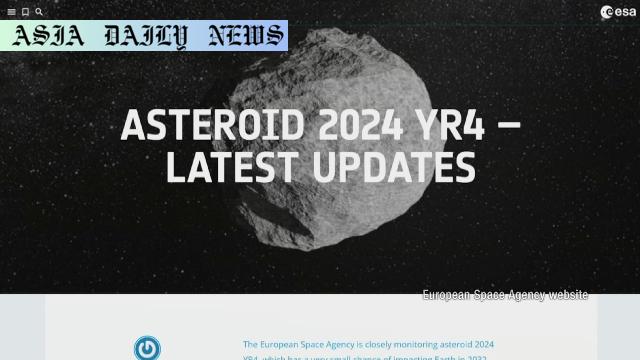Asteroid: ESA warns of a 2.2% chance of asteroid 2024 YR4 hitting Earth on December 22, 2032, with significant local impact potential.
Asteroid 2024 YR4 poses a 2.2% chance of impacting Earth on Dec 22, 2032.
It is estimated to be 40–90 meters wide and capable of causing severe local damage.
ESA is conducting long-term observations to refine its trajectory predictions.
NASA and other agencies are testing defense measures against asteroid threats.

Introduction: Tracking Asteroid 2024 YR4
In a recent announcement, the European Space Agency (ESA) has revealed that an asteroid named “2024 YR4” poses a 2.2% chance of colliding with Earth on December 22, 2032. This asteroid, discovered on December 27 of the previous year, is currently at the top of ESA’s risk list due to its trajectory and size, which ranges between 40 and 90 meters in diameter. If it were to strike, the potential damage could be catastrophic, especially to localized regions. Such an impact is estimated to only occur every few thousand years on average, highlighting the significance of this discovery.
The Risk Assessment
Asteroids passing near Earth are not a rare phenomenon. At present, ESA is actively monitoring over 1,700 asteroids, cataloging them based on their proximity to Earth’s orbit and their size. However, the 2024 YR4 asteroid stands out as a potential threat. A 2.2% chance of impact might appear low, but in astronomical terms, it indicates a considerable risk. Recent calculations suggest that the asteroid, if it impacts, could cause severe consequences, devastating a specific area and its surroundings.
Why Long-Term Observations Matter
One of the most effective measures in planetary defense is detailed monitoring and forecasting of asteroid trajectories. Continuous observation provides astronomers the opportunity to refine asteroid flight paths over time and, in many cases, rule out the risk of collision altogether. Long-term studies of 2024 YR4 are currently being conducted to ensure accurate predictions, which will minimize uncertainty and enhance preparedness.
Hypothetical Impact Scenarios
Should asteroid 2024 YR4 make impact, the results would be localized but impactful. With an estimated width of up to 90 meters, such an asteroid could generate an explosion comparable to a small nuclear bomb. Cities, rural areas, or oceans in the impact zone could face tremendous devastation, including property destruction, loss of life, and environmental consequences. While not on the scale of a planet-wide extinction event caused by much larger asteroids, regional recovery would be a significant challenge.
Advancements in Asteroid Defense Systems
In recent years, space agencies around the world have been developing contingency measures to confront potential asteroid threats. In 2022, NASA conducted a landmark test by intentionally crashing a spacecraft into an asteroid as part of the DART (Double Asteroid Redirection Test) mission. This exercise proved successful in altering an asteroid’s orbit, a promising strategy should intervention become necessary. Other countries are studying similar approaches, including deflection techniques that involve lasers or even kinetic impact.
Collaborative Global Efforts
Global cooperation is at the heart of asteroid-monitoring initiatives. International organizations like ESA, NASA, and Japan’s JAXA have partnered through data sharing, collaborative missions, and the establishment of asteroid risk evaluation systems. These concerted efforts ensure that no asteroid threat is overlooked and that the global community is prepared to address future risks.
Future Implications
The study of asteroid 2024 YR4 underscores the importance of planetary defense systems in ensuring Earth’s safety. With advancements in tracking technologies and ongoing research into mitigation techniques, humanity is becoming better equipped to deal with cosmic challenges. While the likelihood of 2024 YR4 impacting Earth is relatively low, its discovery reminds us to remain vigilant and proactive in protecting our planet.



Commentary
Exploring the Real Consequences of Asteroid Threats
The news about asteroid 2024 YR4 having a 2.2% chance of striking Earth offers both a wake-up call and an opportunity to reflect on our planet’s vulnerability. While the immediate threat may appear small, it highlights our predisposition towards unforeseen cosmic events that could have profound implications on human society. Is our current level of preparedness sufficient? This question needs to be addressed through international cooperation and scientific advancement.
The Growing Importance of Planetary Defense
In recent years, the dedication to planetary defense has grown significantly. Missions such as NASA’s DART exemplify this commitment to exploring real-life solutions to an abstract, yet potentially catastrophic, problem. With 2024 YR4, efforts to refine orbital accuracy through continued observation are crucial. The importance of sustained investments in asteroid trajectory analysis cannot be overstated.
A Call to Global Collaboration
What stands out here is the collective dedication among nations to address shared threats. From data-sharing agreements to co-developed mission strategies, agencies like ESA, NASA, and others remind us that collaboration is sometimes the best defense. The asteroid 2024 YR4 case is yet another reminder that planetary challenges require global solutions that transcend political and geographic barriers. Humanity’s survival depends on such unity.